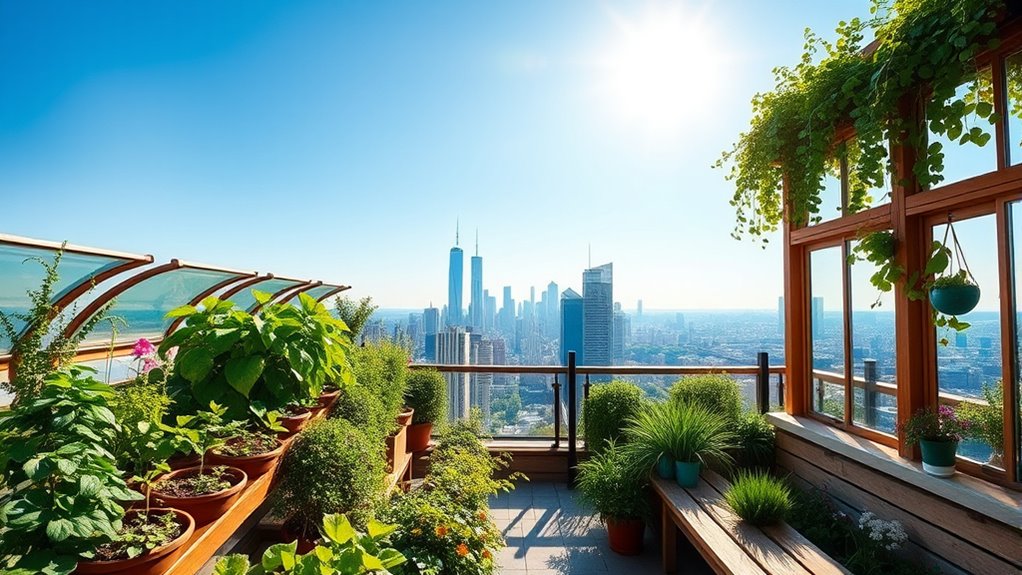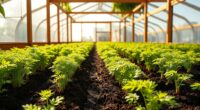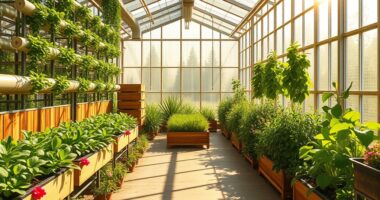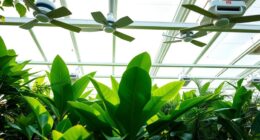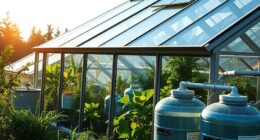When it comes to roof greenhouse designs for urban gardening, I've found a few key factors that really make a difference. You want to take into account climate adaptability, ensuring it can withstand local weather. Structural integrity is essential; a well-pitched roof avoids snow build-up. Choosing the right materials like polycarbonate can maximize light transmission while providing durability. Plus, effective ventilation keeps things cool and fresh. If you stick around, I'll share more tips to create your perfect greenhouse!
Key Takeaways
- Choose a greenhouse design that adapts to your local climate to ensure optimal plant growth and protection from weather extremes.
- Select materials like polycarbonate or glass for their excellent light transmission and durability, enhancing plant health and greenhouse longevity.
- Incorporate sloped or high-pitched roofs to prevent snow accumulation in colder climates and improve ventilation in warmer areas.
- Ensure structural integrity with a load-bearing capacity of at least 20 pounds per square foot to withstand snow and water weight.
- Implement effective ventilation systems, both natural and automated, to regulate temperature and humidity for healthier plants.
Black & Decker Complete Guide to DIY Greenhouses

If you're a DIY enthusiast keen to plunge into urban gardening, "Black & Decker The Complete Guide to DIY Greenhouses" is a must-have resource. This book offers clear construction plans for various greenhouse types, like hoophouses and cold frames. I love the extensive color photography and detailed dimensions, which make building feel achievable. While some measurements may need tweaking, the guidance on essential components like ventilation and insulation is invaluable. Plus, it covers other garden structures, enriching my gardening experience. Whether you're a beginner or seasoned gardener, this guide's practical advice will definitely enhance your greenhouse project.
Best For: DIY enthusiasts and gardeners looking to build their own greenhouses with detailed guidance and construction plans.
Pros:
- Extensive color photography and clear construction plans make building accessible.
- Comprehensive information on essential components such as ventilation, insulation, and maintenance.
- Versatile guide covering various greenhouse types and additional garden structures.
Cons:
- Some measurements may require adjustments during construction due to inaccuracies.
- More advanced builders might find the information too basic.
- Limited coverage on specific plant care techniques within the greenhouse context.
Factors to Consider When Choosing Roofgreenhouse Designs
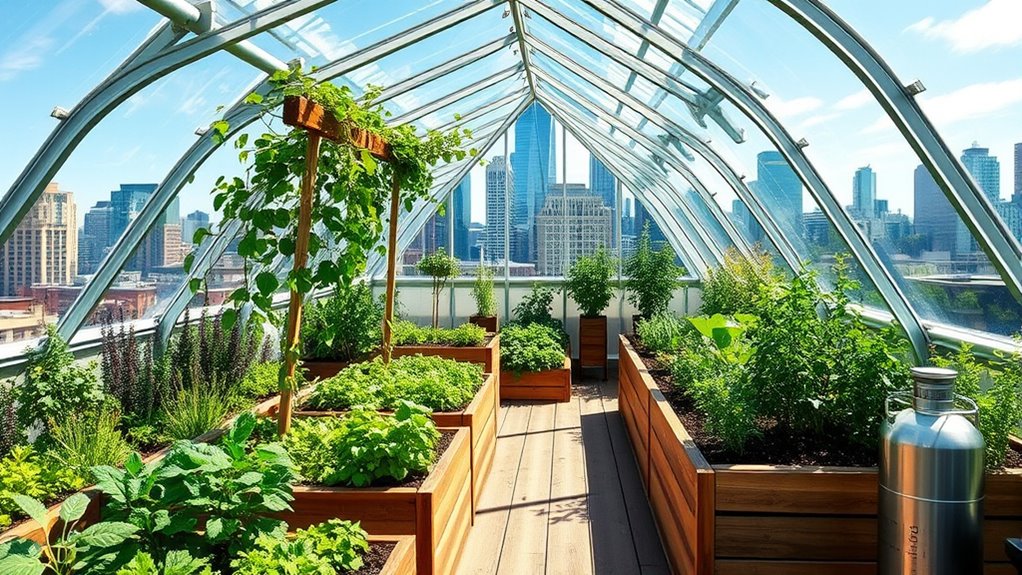
When I think about choosing a roof greenhouse design, several key factors come to mind. I need to take into account climate adaptability, structural integrity, and the right materials to guarantee my plants thrive. Plus, ventilation options and light transmission play a vital role in creating the perfect growing environment.
Climate Adaptability
As I explore greenhouse designs for urban gardening, one of the most critical factors I consider is climate adaptability. It's essential that my greenhouse can withstand local weather conditions, from temperature extremes to humidity levels. In colder climates, I often choose sloped roofs to prevent snow accumulation, while in hotter areas, high-pitched roofs enhance ventilation and reduce heat buildup. I pay attention to roof materials too; polycarbonate offers great insulation, while shade cloths keep things cool in the heat. The orientation of the roof matters, with south-facing roofs capturing winter sunlight, and angled roofs minimizing summer heat absorption. Ultimately, I make sure to incorporate ventilation systems like ridge vents or operable skylights for effective temperature and humidity regulation.
Structural Integrity
While selecting a roof greenhouse design, I prioritize structural integrity to confirm it can withstand the challenges of urban gardening. I know the roof must support the weight of snow, ice, and water, especially in snowy regions where a load-bearing capacity of at least 20 pounds per square foot is essential. I look for designs with an ideal pitch to prevent water pooling and guarantee snow slides off easily. Ventilation is also key; it helps hot air escape, maintaining both the greenhouse's integrity and the plants' health. Regular maintenance and inspections are non-negotiable for identifying wear and tear, confirming my greenhouse remains safe and effective for growing a thriving garden in the city.
Material Selection
Choosing the right materials for a roof greenhouse is essential to ensuring a thriving urban garden. I always consider light transmission first, as materials like polycarbonate and glass can let in up to 90% of sunlight, which plants need. Durability and weather resistance are also important; materials like metal and fiberglass can withstand harsh elements, ensuring longevity. Insulation properties play a role too; higher R-values, such as in double-walled polycarbonate, help maintain stable temperatures. Weight matters, too—lighter materials like polyethylene film are easier to install but may need more frequent replacement, while heavier options like glass offer durability. Finally, I weigh costs against long-term benefits to make the best choice for my budget and garden's needs.
Ventilation Options
After selecting the right materials for my roof greenhouse, I focus on ventilation options to create the ideal environment for my plants. Proper ventilation's essential; it regulates temperature and humidity, preventing overheating and promoting healthy growth. I consider natural ventilation, which can be achieved with roof vents that let hot air escape while cooler air enters through side vents, ensuring passive airflow. For larger structures, I lean towards automated systems with motorized vents and exhaust fans for precise climate control. I also keep in mind that the total area of vents should be about 10% of the greenhouse floor area for best air exchange. Finally, adjustable vents provide flexibility, allowing me to manage ventilation needs through different seasons and weather conditions.
Light Transmission
When I design my roof greenhouse, I pay close attention to light transmission, as it plays an essential role in plant growth and overall health. I aim for a light transmission rate between 70% to 90%, which is ideal for most crops. I often choose clear glass for its impressive 90% light transmission, but I also consider polycarbonate options that offer about 80%. The roof angle is another factor; a sloped design maximizes sunlight exposure and minimizes shading. I keep in mind the local climate and seasonal changes, ensuring my plants receive adequate light year-round. Additionally, I monitor the condition of my coverings, as older materials can lose significant light transmission over time.
Aesthetic Considerations
While designing my roof greenhouse, I consider aesthetic factors that enhance both its functionality and visual appeal. The architectural style should harmonize with my surrounding landscape, creating a seamless integration. I've found that the choice of materials, like classic glass or modern polycarbonate, dramatically influences the overall look. I prefer neutral tones that blend into nature, but a splash of vibrant color can make my greenhouse a stunning focal point. Additionally, the roof shape—be it gabled, curved, or flat—affects not just aesthetics but also light distribution. To complete the look, I add decorative trim, window boxes, and landscaping around the greenhouse, which makes my garden space more inviting and attractive.
Frequently Asked Questions
How Much Sunlight Do Roof Greenhouses Need Daily?
I've found that roof greenhouses generally need about six to eight hours of direct sunlight each day for ideal plant growth. This sunlight helps maintain the right temperature and encourages healthy photosynthesis. I always check the sun patterns in my area to guarantee my greenhouse gets enough light. If my plants seem leggy or weak, I know it's time to adjust their position or consider using supplemental grow lights.
What Plants Grow Best in Urban Roof Greenhouses?
When I think about plants that thrive in urban roof greenhouses, I can't help but consider a few favorites: fresh fruits, fabulous herbs, and vibrant veggies. Strawberries, basil, and cherry tomatoes flourish in those sunlit spaces. I've found that leafy greens like spinach and kale also do well, enjoying the warmth and light. If you choose the right plants, your rooftop oasis can burst with color and flavor, turning it into a green getaway!
Can I Build a Roof Greenhouse on Any Type of Building?
Absolutely, you can build a roof greenhouse on many types of buildings, but there are a few things to keep in mind. I've learned that the structure needs to support the additional weight, so checking with a professional is vital. Also, consider local regulations and zoning laws since they can affect your plans. I've found that evaluating sunlight and wind exposure is critical for a successful rooftop garden, too!
How Do I Maintain Temperature in a Roof Greenhouse?
Maintaining temperature in my roof greenhouse can be a challenge, but I've found some effective strategies. I use shade cloth during the hottest days to prevent overheating and guarantee good air circulation. I also install a small fan to promote airflow. When it gets cold, I rely on thermal mass—like water barrels—to retain heat. Additionally, I monitor the temperature regularly, adjusting my methods as needed to keep my plants happy and thriving.
Are There Local Regulations for Building Roof Greenhouses?
When I wanted to build my roof greenhouse, I quickly found out that local regulations can vary greatly. I checked with my city's zoning office to understand height restrictions, permits, and safety codes. It's essential to make sure my plans comply with these regulations to avoid any fines or issues down the road. If you're considering a similar project, I recommend doing the same to guarantee a smooth building process.
Conclusion
As I wrap up this guide, I can't help but feel a rush of excitement about the possibilities a roof greenhouse brings to urban gardening. Imagine stepping onto your rooftop oasis, surrounded by flourishing plants, all while enjoying the city skyline. But remember, choosing the right design is essential—one misstep could mean the difference between a thriving garden and a wilted dream. So, are you ready to transform your rooftop into a green paradise? The adventure awaits!
